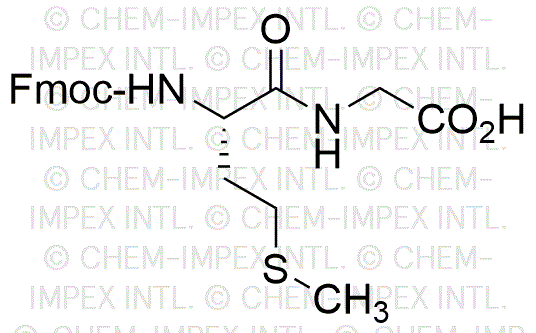Fmoc-Met-Gly-OH is widely utilized in research focused on:
- Peptide Synthesis: This compound serves as a key building block in the synthesis of peptides, particularly in solid-phase peptide synthesis (SPPS). Its Fmoc protecting group allows for selective deprotection, facilitating the assembly of complex peptides.
- Drug Development: In pharmaceutical research, it is used to create peptide-based drugs. The ability to modify the peptide structure enhances the efficacy and specificity of drug candidates, making them more effective in targeting diseases.
- Bioconjugation: Fmoc-Met-Gly-OH is employed in bioconjugation processes, where it can be attached to various biomolecules. This is particularly useful in developing targeted therapies and diagnostics in the biomedical field.
- Protein Engineering: Researchers utilize this compound to introduce specific amino acids into proteins, allowing for the study of protein function and interactions. This application is crucial in understanding disease mechanisms and developing new treatments.
- Research in Neuroscience: It plays a role in synthesizing neuropeptides, which are important for understanding neural communication and developing treatments for neurological disorders.
General Information
Properties
Safety and Regulations
Applications
Fmoc-Met-Gly-OH is widely utilized in research focused on:
- Peptide Synthesis: This compound serves as a key building block in the synthesis of peptides, particularly in solid-phase peptide synthesis (SPPS). Its Fmoc protecting group allows for selective deprotection, facilitating the assembly of complex peptides.
- Drug Development: In pharmaceutical research, it is used to create peptide-based drugs. The ability to modify the peptide structure enhances the efficacy and specificity of drug candidates, making them more effective in targeting diseases.
- Bioconjugation: Fmoc-Met-Gly-OH is employed in bioconjugation processes, where it can be attached to various biomolecules. This is particularly useful in developing targeted therapies and diagnostics in the biomedical field.
- Protein Engineering: Researchers utilize this compound to introduce specific amino acids into proteins, allowing for the study of protein function and interactions. This application is crucial in understanding disease mechanisms and developing new treatments.
- Research in Neuroscience: It plays a role in synthesizing neuropeptides, which are important for understanding neural communication and developing treatments for neurological disorders.
Documents
Safety Data Sheets (SDS)
The SDS provides comprehensive safety information on handling, storage, and disposal of the product.
Product Specification (PS)
The PS provides a comprehensive breakdown of the product’s properties, including chemical composition, physical state, purity, and storage requirements. It also details acceptable quality ranges and the product's intended applications.
Certificates of Analysis (COA)
Search for Certificates of Analysis (COA) by entering the products Lot Number. Lot and Batch Numbers can be found on a product’s label following the words ‘Lot’ or ‘Batch’.
*Catalog Number
*Lot Number
Certificates Of Origin (COO)
This COO confirms the country where the product was manufactured, and also details the materials and components used in it and whether it is derived from natural, synthetic, or other specific sources. This certificate may be required for customs, trade, and regulatory compliance.
*Catalog Number
*Lot Number
Safety Data Sheets (SDS)
The SDS provides comprehensive safety information on handling, storage, and disposal of the product.
DownloadProduct Specification (PS)
The PS provides a comprehensive breakdown of the product’s properties, including chemical composition, physical state, purity, and storage requirements. It also details acceptable quality ranges and the product's intended applications.
DownloadCertificates of Analysis (COA)
Search for Certificates of Analysis (COA) by entering the products Lot Number. Lot and Batch Numbers can be found on a product’s label following the words ‘Lot’ or ‘Batch’.
*Catalog Number
*Lot Number
Certificates Of Origin (COO)
This COO confirms the country where the product was manufactured, and also details the materials and components used in it and whether it is derived from natural, synthetic, or other specific sources. This certificate may be required for customs, trade, and regulatory compliance.


